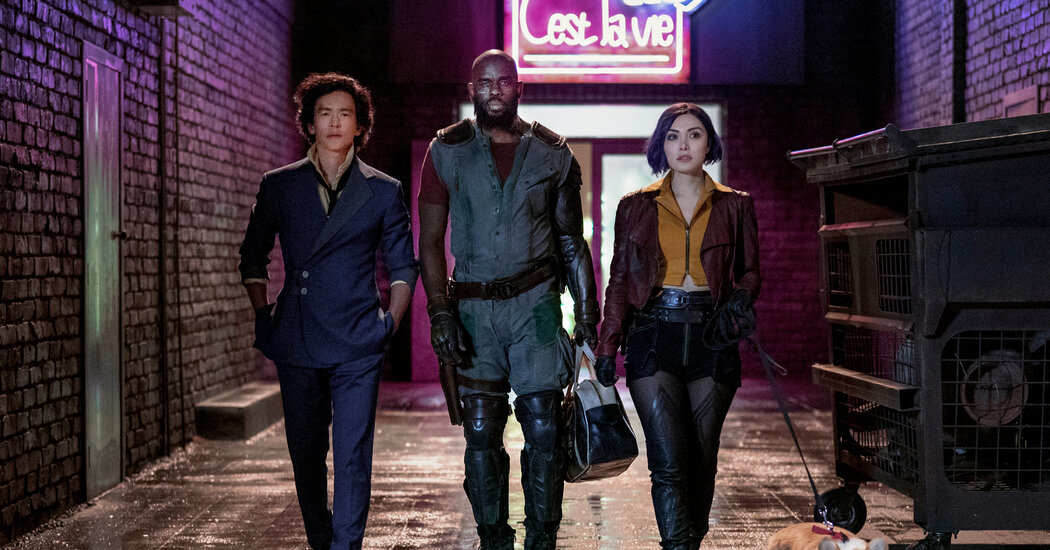
“Cowboy Bebop,” an anime series that ran for one season in Japan 22 years ago, inspires a particular kind of devotion.
A 1:1 mix of sci-fi western and film noir, steeped in American jazz and blues and framed by retro James Bond-meets-Blue Note credits, it was guaranteed to spawn a reverent cult — custom made for the more refined class of what would soon be called fanboys. (“Fanboy” is used here with no pejorative intent. When it comes to the original “Cowboy Bebop,” I absolutely am one.)
This means that it’s also guaranteed that Netflix’s new “Cowboy Bebop,” an American-made live-action version starring John Cho as the space-traveling bounty hunter Spike Spiegel, will undergo a particular kind of scrutiny. Inquisitors will ferret out departures from the true faith. Scorekeepers will catalog the discrepancies.
That kind of compare-and-contrast is beside the point with the old “Cowboy Bebop,” however, and unfair to the new. The appeal of the anime — a laconic, melancholy jewel box of mood and style and gesture, built on a solid foundation of shoot-em-up action and deadpan humor — is a product of the kind of control an artist like its director, Shinichiro Watanabe, can exercise in animation. Replicating that kind of effect in live action requires a singular filmmaker, a massive budget, or both.
So what’s a fair, on-its-own-terms assessment of the new “Bebop”? It’s … OK. It’s not an embarrassment. As jokey, episodic sci-fi action series with visual effects at the cheesy-adequacy level of “Doctor Who” go, it’s even slightly above average, though that’s not a strong argument for sitting through 10 episodes.
Cho’s Spiegel and his bounty-hunting partner, Jet Black (Mustafa Shakir), pilot a ship called the Bebop around the galaxy sometime after the “fall” of the home planet Earth. They’re both fallen themselves — Black a disgraced cop, Spiegel a former assassin for a brutal crime ring known as the Syndicate. On their travels, they’re joined by a tough dame going by the name of Faye Valentine (Daniella Pineda), whose memory of her actual identity has been erased.
Spiegel is headed toward a reckoning with Vicious (Alex Hassell), his onetime Syndicate pal and rival for the affections of the show’s femme fatale, Julia (Elena Satine). Getting to that showdown within the first season — in several hundred minutes’ less running time than the anime season runs, not even counting the 2001 “Cowboy Bebop” animated feature — means leaving things out, like the red-haired hacker Radical Ed, and reducing the time given to others, like the lovable and talented corgi Ein.
Changes like those may bother the fans of the original. What should bother everyone is that the compression shifts the balance of the story away from episodic adventures on scattered planets, and toward the mechanics of a hackneyed noir revenge fantasy. What was back story through much of the anime is now foregrounded, and the result is that the show hollows out toward the end of the season, with three final episodes of tragic-romantic posturing punctuated by mindless (and indifferently filmed) gunplay and martial arts.
Before that, things are sprightlier. Cho and Shakir have a good rapport, and their sensitive-macho banter is entertaining. Pineda brings verve and energy as the foul-mouthed Faye, and the three performers’ scenes together have an easy comic snap. Cho, with his ability to shade any kind of dialogue with tones of melancholy and regret, is well cast in the central role.
And before the show settles in for its grim denouement, the trio’s adventures offer some visual variety and opportunities for appealing guest stars, like Adrienne Barbeau as a scheming eco-warrior and Christine Dunford as a con woman from Faye’s past.
“Cowboy Bebop” was developed by André Nemec, a creator of broadcast-network shows like “Zoo” and “October Road” and an author of the “Mission Impossible: Ghost Protocol” screenplay. Under his guidance, the series has a routine professionalism that serves it well in its lighter moments but doesn’t alleviate the drudgery of its later episodes.
The new series has brought back the composer of the anime’s distinctive score, Yoko Kanno, and created analogues of the original’s snazzy credits. It has kept the conceit of calling the episodes “sessions” and aped other aspects of typography and graphics.
All of that begs a comparison that the show itself can’t live up to, and shouldn’t have to. But in its resolute ordinariness, the main value of this new “Bebop” would be to drive you back to watch the old one.


More Stories
Prince Harry: I want my father and brother back
Jeremy Renner, Marvel’s Hawkeye, has surgery after snow plough accident
Marvel actor Jeremy Renner in ‘critical condition’ after snow plough accident